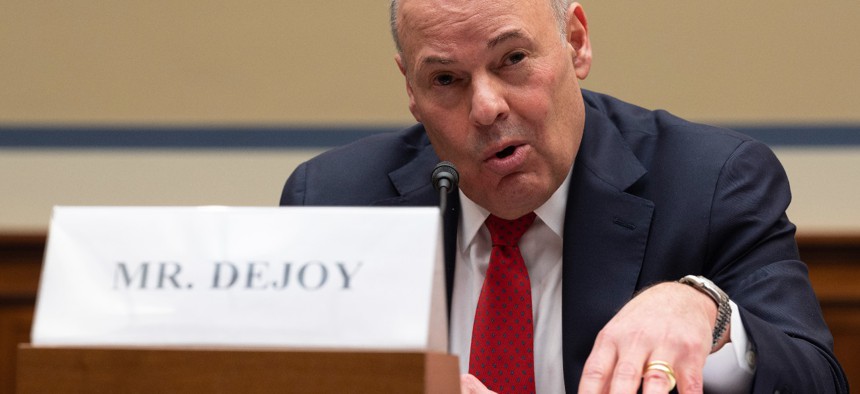
Postmaster General Louis DeJoy said the surprise increase in EVs was due to "improved conditions." Jim Watson-Pool/Getty Images
USPS Has Placed Its First Order for New Vehicles, and It's Going More Electric Than Anticipated
"Improved conditions" have altered USPS plans, postmaster general says.
The U.S. Postal Service on Thursday officially ordered 50,000 vehicles to begin replacing its aging fleet, and in a surprise move announced 20% of those will be electric.
The first purchase with Oshkosh Defense will be worth just shy of $3 billion, though the order represents less than one-third of what USPS eventually plans to buy. The contract has garnered significant attention from lawmakers, the Biden administration and stakeholders who have pushed postal management to buy more EVs and fewer internal combustion engine vans and trucks.
Postmaster General Louis DeJoy had committed to buying just 10% of the new fleet as EVs, saying the mailing agency would require funding from Congress to alter that plan. He made clear, however, that the 10% rate was just a starting point. Due to “improved conditions,” DeJoy said Thursday he was upping the EV purchase to 20% of the 50,000 new vehicles. The figure still falls well short of the 75% rate for which many Democratic lawmakers have pushed.
“Based upon this work and our improving outlook, we have determined that increasing our initial electric vehicle purchase from 5,000 to 10,019 makes good sense from an operational and financial perspective,” DeJoy said. “Today’s order demonstrates, as we have said all along, that the Postal Service is fully committed to the inclusion of electric vehicles as a significant part of our delivery fleet even though the investment will cost more than an internal combustion engine vehicle.”
The USPS inspector general found last week that EVs would be cheaper in the long run for longer delivery routes, especially those in areas with particularly high gas prices. Postal management could also consider not buying one charging station for every EV, the IG said, which would also make their purchase more economically viable.
The Postal Service has warned for a decade about its low cash-on-hand, though that total has skyrocketed in the last two years and sat at $23 billion at the end of 2021. USPS has for years been straddled with debt in large part due to missed statutorily required payments to its fund health care benefits for future retirees, but Congress this month passed a bipartisan bill that erased much of those negative balances.
USPS selected Oshkosh last year to build up to 165,000 vehicles. The contract award came with an initial $482 million to design and prepare for manufacturing. The Postal Service’s “next generation delivery vehicle” search has lasted several years and gone through multiple delays, though its aging fleet and reports of trucks catching fire gave the process urgency. The new vehicles will for the first time provide air conditioning for drivers, and come with new ergonomic advantages, safety features such as backup cameras and more efficient use of space to accommodate packages.
USPS first issued a request for proposals for its next-generation delivery fleet in early 2015. It had at that point spent years discussing the need to replace its fleet, but said it did not have the funds as it lost billions of dollars annually. The Government Accountability Office first suggested USPS address its aging fleet a decade ago, though it noted at the time the agency did not have the necessary cash on hand to do so. The Postal Service began leasing more of its vehicles in 2013, but in 2016 awarded contracts to six companies to build delivery vehicle prototypes. After testing those models, USPS delayed its selection.
The new vehicles are expected to hit the road in late 2023.
Both the Environmental Protection Agency and the White House’s Council on Environmental Quality have pushed USPS to slow down its procurement to further study the environmental impact of purchasing primarily gas-powered vehicles, saying management violated statutory and regulatory obligations. USPS rejected those assertions, saying further consideration would not yield better information or change the agency’s decisions.
“As we have also stated repeatedly, we must make fiscally prudent decisions in the needed introduction of a new vehicle fleet,” DeJoy said Thursday. “We will continue to look for opportunities to increase the electrification of our delivery fleet in a responsible manner, consistent with our operating strategy, the deployment of appropriate infrastructure, and our financial condition, which we expect to continue to improve as we pursue our plan.”
The USPS IG recently announced it would further investigate the Oshkosh contract and whether postal management has met its obligations for environmental reviews. Rep. Gerry Connolly, D-Va., who chairs the House Oversight and Reform panel with direct oversight of the Postal Service, has introduced legislation that would require USPS to replace at least 75% of its fleet with EVs.
“This is still woefully short of what the USPS should do in transitioning to the clean EV vehicle fleet of tomorrow,” Connolly said of the Thursday announcement. “It’s time to be bold and visionary, not settle for a Band-Aid on this problem. Congress must pass the Green Postal Service Fleet Act.”
The White House and congressional Democrats have both proposed providing $6 billion for USPS to electrify its fleet, though the vehicle for that funding—the Build Back Better Act—remains in limbo. President Biden has called on the entire federal government to switch to electric vehicles over the coming decades.







